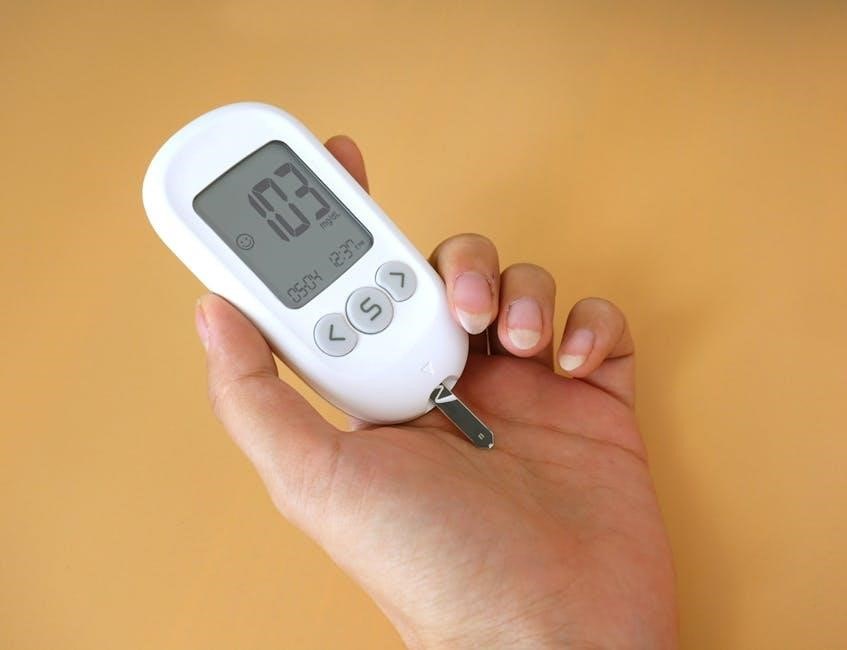gestational diabetes log sheet pdf
A gestational diabetes log sheet is an essential tool for tracking blood sugar levels, meals, and physical activity during pregnancy․ It helps manage the condition effectively and supports a healthy pregnancy outcome by monitoring daily habits and glucose trends․
1․1 What is a Gestational Diabetes Log Sheet?
A gestational diabetes log sheet is a personalized tool designed for women diagnosed with gestational diabetes during pregnancy․ It allows them to track daily blood sugar levels, meals, physical activity, and medication doses․ This log helps monitor glucose trends, ensuring levels remain within a healthy range․ It typically includes sections for fasting and postprandial readings, meal details, exercise routines, and space for notes․ The log sheet is customizable and can be printed or accessed digitally, making it easy to share with healthcare providers for better pregnancy management and personalized care plans․
1․2 Importance of Tracking Blood Sugar During Pregnancy
Tracking blood sugar during pregnancy is crucial for managing gestational diabetes effectively․ It helps identify patterns and trends, ensuring levels stay within a healthy range to protect both mother and baby․ Consistent monitoring prevents complications like macrosomia or preterm delivery while optimizing treatment plans․ By logging readings, women can understand how meals, activity, and medications impact their glucose levels, enabling better decision-making․ Regular tracking also facilitates clear communication with healthcare providers, allowing for timely adjustments to care plans and ensuring the best possible outcomes for a healthy pregnancy and delivery․
Key Components of a Gestational Diabetes Log Sheet
A log sheet typically includes blood sugar readings, meal tracking, exercise and activity levels, medication doses, and additional notes for comprehensive monitoring and management of gestational diabetes․
2․1 Blood Sugar Readings
Blood sugar readings are a critical component of a gestational diabetes log sheet․ They typically include fasting levels, pre-meal readings, and postprandial measurements, often taken at specific intervals such as two hours after meals․ These readings help identify patterns and trends, ensuring levels remain within target ranges, usually between 60-95 mg/dL for fasting and below 120 mg/dL after meals․ Accurate recording allows healthcare providers to assess control and make necessary adjustments to treatment plans, promoting better health outcomes for both mother and baby․
2․2 Meal Tracking
Meal tracking is a vital part of a gestational diabetes log sheet, helping monitor carbohydrate intake and glycemic impact․ It involves recording the time of meals, portion sizes, and specific foods consumed, along with their macronutrient breakdown․ This section also allows for noting the preparation method and any added sugars or fats․ By documenting meals, individuals can identify dietary patterns that affect blood sugar levels and make informed adjustments․ This detailed tracking supports personalized meal planning and helps maintain blood glucose within target ranges, ensuring better overall management of gestational diabetes․
2․3 Exercise and Activity Levels
Tracking exercise and activity levels in a gestational diabetes log sheet helps monitor how physical activity impacts blood sugar․ This section includes the type, duration, and intensity of exercises, such as walking, swimming, or strength training․ It also notes daily activities like housework or work-related movements․ By recording exercise routines, individuals can observe how different activities influence their glucose levels, enabling better management of blood sugar fluctuations․ Consistent tracking supports the creation of a balanced exercise plan, which is crucial for maintaining healthy blood sugar levels during pregnancy and overall well-being․
2․4 Medication and Insulin Doses
Recording medication and insulin doses in a gestational diabetes log sheet is crucial for managing blood sugar levels effectively․ This section allows individuals to note the type, dosage, and timing of medications or insulin administered․ It also helps track any adjustments made by healthcare providers․ Accurate documentation ensures consistency in treatment and provides valuable insights for healthcare providers to fine-tune the management plan․ By monitoring medication adherence and its impact on blood sugar, individuals can achieve better control over their gestational diabetes, ensuring a healthier pregnancy outcome and reducing potential complications․
2․5 Additional Notes and Comments
The additional notes and comments section in a gestational diabetes log sheet allows individuals to document any unusual symptoms, side effects, or concerns․ This space can be used to record how certain foods or activities impacted blood sugar levels, note any stress or illness, and track overall well-being․ It also provides an area to jot down questions or observations to discuss with healthcare providers․ Including these details helps identify patterns and supports personalized adjustments to the management plan, ensuring a more comprehensive approach to gestational diabetes care․

How to Create a Gestational Diabetes Log Sheet
Creating a gestational diabetes log sheet involves selecting a format, whether digital or printable, and including essential sections like blood sugar readings, meal tracking, exercise, and medication․ Start by identifying the components you need, such as fasting and postprandial glucose levels, meal details, and activity logs․ You can download a PDF template or design one from scratch using spreadsheet software․ Ensure the log is user-friendly, with clear headings and ample space for entries․ Customize it to fit your specific needs, and consider adding examples or guidelines for consistency․ This personalized approach helps streamline tracking and ensures accurate monitoring throughout your pregnancy․
3․1 Downloading a PDF Template
Downloading a gestational diabetes log sheet PDF is a convenient way to start tracking your health․ Many websites offer free templates designed specifically for gestational diabetes, such as blood glucose monitoring logs or meal trackers․ Platforms like pdfFiller allow you to edit and print these templates directly․ Look for templates that include sections for fasting and postprandial blood sugar readings, meal details, exercise, and medication․ These templates are often fillable online, saving you time and ensuring consistency․ They are also printable, making it easy to maintain a physical record․ Downloading a PDF template provides a structured and professional format for managing your gestational diabetes effectively․
3․2 Customizing the Log Sheet
Customizing a gestational diabetes log sheet allows you to tailor it to your specific needs․ Start by adding your name, due date, and blood sugar target ranges․ You can modify sections to include meal planning, carbohydrate counting, or exercise routines․ Many templates offer editable fields, enabling you to highlight key areas like fasting glucose or postprandial readings․ Some users prefer adding columns for insulin doses or notes about how meals affect their blood sugar․ Tools like PDF editors or online platforms can help you personalize the layout and ensure the log is user-friendly․ Customization makes tracking more efficient and relevant to your daily routine․
3․3 Filling Out the Log Sheet
Filling out a gestational diabetes log sheet involves recording daily blood sugar readings, meals, exercise, and medications․ Start by noting the date and time of each entry․ Record fasting blood sugar levels first thing in the morning and after each meal, comparing them to your target ranges․ Document the types and portions of food consumed, as well as any physical activity․ If medications or insulin are used, include dosages and times administered․ Add notes about any symptoms, cravings, or concerns․ Consistency and accuracy are key to making the log useful for managing your condition and discussing with healthcare providers․ Keep it organized and review regularly․

Benefits of Using a Gestational Diabetes Log Sheet
Using a gestational diabetes log sheet improves blood sugar control, enhances communication with healthcare providers, and increases awareness of how diet and lifestyle impact glucose levels․
4․1 Improved Blood Sugar Management
A gestational diabetes log sheet helps maintain healthy blood sugar levels by tracking daily readings, identifying patterns, and ensuring targets are met․ Regular monitoring allows for timely adjustments to diet, exercise, or medication, preventing extreme glucose fluctuations․ By documenting fasting and post-meal readings, individuals can better understand how different factors influence their blood sugar․ This proactive approach minimizes the risk of complications and supports a healthy pregnancy outcome․ Consistent logging also helps set clear goals, such as maintaining fasting levels between 60-95 mg/dL and post-meal levels below 120 mg/dL, ensuring better overall glucose control and peace of mind․
4․2 Better Communication with Healthcare Providers
A gestational diabetes log sheet enhances communication between patients and healthcare providers by providing a clear, organized record of blood sugar levels, meals, and activities․ This detailed documentation allows providers to assess progress, identify patterns, and make informed adjustments to treatment plans․ Sharing the log sheet during appointments ensures accurate guidance and supports better decision-making․ It also helps healthcare providers understand the patient’s daily habits and challenges, fostering a more collaborative approach to managing gestational diabetes and ensuring the best possible outcomes for both mother and baby․
4․3 Enhanced Awareness of Dietary and Lifestyle Impact
Using a gestational diabetes log sheet increases awareness of how diet and lifestyle impact blood sugar levels․ By tracking meals, portion sizes, and physical activity, individuals can identify which foods and habits raise or lower their glucose levels․ This insight helps guide better food choices and meal planning․ It also reveals how exercise, stress, and sleep affect blood sugar, enabling women to make informed decisions․ Over time, this awareness empowers individuals to adopt healthier habits, manage their condition more effectively, and reduce the risk of complications during pregnancy․

Tips for Effective Logging
Record blood sugar levels consistently, note meals and portions, and track physical activity․ Use both digital apps and a physical log for accuracy and backup․
5․1 Consistency in Recording
Consistency is key to effective logging․ Record blood sugar levels, meals, and physical activity daily at the same time․ Use a digital app or physical log to ensure accuracy and backup․ Track fasting and postprandial readings, noting meal times, portions, and any symptoms․ Regular logging helps identify patterns and trends, enabling better blood sugar management․ Inconsistent recording can lead to missed insights, making it harder for healthcare providers to offer guidance․ Aim to log every day, even if it’s just a few quick notes, to maintain a clear and comprehensive record of your progress and health․
5․2 Accuracy of Entries
Accuracy in logging is crucial for effective blood sugar management․ Record exact blood glucose readings, meal portions, and insulin doses to avoid confusion․ Note the timing of meals and activities, as delays can impact readings․ Include any symptoms like dizziness or nausea, and document adjustments made to diet or medication․ Precise entries help healthcare providers identify trends and make informed decisions․ Avoid guessing or estimating values; use a glucose meter for accurate readings․ Detailed and truthful logging ensures personalized care and better pregnancy outcomes, making it a vital part of managing gestational diabetes effectively․
5․3 Reviewing and Adjusting
Regularly reviewing your log sheet helps identify trends and patterns in blood sugar levels․ Use this information to adjust your diet, exercise, or medication as needed․ Discuss your entries with your healthcare provider to refine your management plan․ Look for consistent high or low readings to pinpoint triggers, such as specific foods or activities․ Adjusting your approach based on log data ensures better blood sugar control and a healthier pregnancy outcome․ Schedule regular reviews to stay on track and make timely changes for optimal gestational diabetes management․

Common Mistakes to Avoid
- Incomplete Entries: Missing blood sugar readings or meal details can hinder effective tracking and management․
- Incorrect Targets: Using wrong blood sugar goals may lead to poor control and health risks․
- Ignoring Patterns: Failing to identify trends can prevent necessary adjustments in diet or treatment plans․
6․1 Incomplete Entries
One common mistake is failing to fill out all sections of the log sheet, such as skipping blood sugar readings or omitting meal details․ Incomplete entries can make it difficult to track patterns and manage gestational diabetes effectively․ For example, forgetting to record carbohydrate intake or physical activity levels can lead to inaccurate assessments of blood sugar trends․ Consistency is key, as missing data can hinder healthcare providers from making informed decisions․ Always ensure every section is filled out, even if it seems minor, to maintain a comprehensive and useful record․
6․2 Incorrect Blood Sugar Targets
Using incorrect blood sugar targets is a common mistake that can lead to poor management of gestational diabetes․ Standard targets for fasting blood sugar typically range from 60 to 95 mg/dL, while postprandial levels should be below 120 mg/dL․ If these targets are not accurately recorded or followed, it can result in hyperglycemia or hypoglycemia, both of which pose risks to the mother and baby․ Always ensure targets align with healthcare provider recommendations and are tailored to individual needs․ Misusing generic targets can hinder effective glucose control and complicate pregnancy outcomes․
6․3 Ignoring Patterns and Trends
Ignoring patterns and trends in blood sugar levels is a critical mistake that can hinder effective gestational diabetes management․ Consistently high or low readings at specific times may indicate underlying issues, such as dietary choices or insulin resistance․ Failing to recognize these trends can lead to poor glucose control, increasing the risk of complications like preeclampsia or fetal growth issues․ Regularly reviewing the log sheet helps identify patterns, enabling timely adjustments to diet, exercise, or medication․ Proactive management of trends ensures better health outcomes for both mother and baby, making it essential to analyze and act on the data recorded․
A gestational diabetes log sheet is a vital tool for managing blood sugar, ensuring a healthy pregnancy, and fostering better communication with healthcare providers․ Consistent use is key․
7․1 Summary of Key Points
A gestational diabetes log sheet is a crucial tool for managing blood sugar, diet, and activity during pregnancy․ It helps track glucose levels, meal intake, exercise, and medication doses, ensuring better health outcomes․ By monitoring patterns, women can make informed lifestyle adjustments and communicate effectively with healthcare providers․ Consistent logging improves blood sugar control, enhances awareness of dietary impacts, and supports personalized care plans․ Ultimately, it empowers women to manage gestational diabetes proactively, promoting a healthier pregnancy and reducing risks for both mother and baby․
7․2 Encouragement for Continuous Use
Using a gestational diabetes log sheet consistently empowers women to take control of their health during pregnancy․ By diligently tracking blood sugar, meals, and activities, expectant mothers can identify patterns and make informed decisions to maintain balanced glucose levels․ This proactive approach fosters a healthier pregnancy, reduces complications, and ensures the well-being of both mother and baby․ Continuous use of the log sheet also enhances communication with healthcare providers, allowing for personalized care and timely adjustments․ Stay committed to logging—it’s a simple yet powerful tool for a safer and more manageable pregnancy journey․